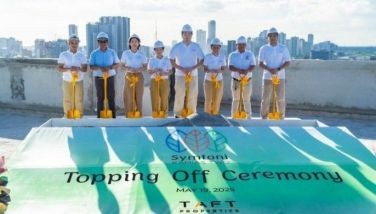Wearing the terno today
MANILA, Philippines - Donning the terno today speaks volumes and designer JC Buendia’s clientele are listening. The terno is again a favorite for weddings, fashion shows, and galas, events decked with on-trend Western style sensibilities only half a decade ago.
“Before, we associated wearing a terno with a first lady, with our lolas, with wedding ceremonies and inaugurals. I guess it was dictated by tradition,†the Fashion and Design Council of the Philippines president explains. “Because Filipinas have become global, we are proud of our identity. Today, wearing a terno means you’re proud to be a Filipina.â€
This renewed ardour is necessary to revitalize our indigenous textile industry. The way our fabrics are produced is ingrained in a cultural process, with elders passing down their skills. It’s literally a dying art, because no business for these craftsmen means the age-old process is slowly being abandoned.
A visionary breed of young fashion designers seeks to reinterpret the modern terno in this year’s Philippine Fashion Design Competition, rising to the challenge of promoting not only the terno but also the use of indigenous materials.
The terno’s iconic wearers make it a symbol not only of elegance and femininity today but also of influence. Jonah Bengt Enrique of Davao says, “It’s that garment that showcases a woman’s power and femininity. It gives a woman a boost of confidence and an aura of sophistication.†With his oversized panuelos made of photo-luminescent fibers and hair-thin stainless steel wires hand-woven with piña, abaca, and silk, Enrique’s terno also exudes shine.
John Michael Dimacali of Pampanga was inspired by the stylish, terno-wearing women he looks up to: his lolas. He retained the original shape of the butterfly sleeves and turned the terno’s A-line shape into piña pants. Cage blazers done in the weaving technique for solihiya furniture give his design an unexpected modernity.
“Confidence is an endlessly attractive trait for any woman,†says Rafael Mejia of Manila. Pulling off a terno today requires it, and his extended butterfly sleeves-cum-cape does. “The terno represents a culture of refined dressing. Women should don it with delicacy and grace befitting its tradition.†Mejia was modest in his textile experimentation, using piña with geometric cutouts in the weaving pattern of the familiar abaniko. “I wanted the material to be accessible and recognizable as a Philippine-made fabric.â€
Gilmar Thonee Llaneras of Albay cinches the waist and raises the neckline and the hemline. “The modern Filipina is sure of herself, definitely one who knows how to make an impression.â€
“Wearing a terno today is like going back to your roots amid innovations and technologies. It involves guts to be a head-turner, but you know it is worth the risk,†Mark Joseph Alminanza of Zambales muses. He made the terno’s loose silhouette boxy and androgynous, then peppered his piece with Braille to show that fashion does not discriminate.
Candle Ray Torreverde used Iloilo’s indigenous textile hablon to create lines with an athletic flair. “My collection epitomizes a Filipina who is ready to conquer the world while holding on to her values,†he declares. “It is more than just wearing a national costume. It is a way of giving respect and importance to our own culture.â€
“Working with indigenous fabrics requires bravery,†says Marion Isabel Solon of Negros Oriental. For her, restoring the indigenous textile industry means reinforcing the value of craftsmanship. “I admire the Filipina who wears quality clothes, but also takes into consideration their individuality and cultural identity.â€
Charinson Balalihe of Negros Occidental experimented with textiles by superimposing Philippine sea snake leather in pandan and cutting it into a sleek silhouette. “I created my designs to make the terno more fashion forward.â€
Denim and draped dresses are two Western fashion influences that are very popular today; Irene Subang of Negros Occidental combines them into a terno, splashed with paint like they did in Lewis Carroll’s Alice in Wonderland. “I chose Alice because she represents the youth and I want my designs to be relevant to a young audience,†she explains.
The year’s big trends, the cropped top and the high-waisted shorts, are turned into a terno by Vince Tolentino, who painted Bicol’s pinukpok fabric in the colors of a flame. “I also created more modern butterfly sleeves that are something more wearable for today.â€
“Wearing a terno is like carrying an emblem of our history, (from) the focus of pre-colonial Filipinos on wearability and practical elegance (to) the colonial and post-colonial elite’s lavish luxuries and flamboyance,†Rakiel Aurora Talan of Antipolo explains, and the historical references are apparent in her dissection of the original terno.
Maureen Lezama from Negros Occidental revives the silhouette of the Manton de Manila with traditional butterfly sleeves and makes the sinamay wearable by weaving soft fibers into it. She enthuses, “You are not only taking pride in the person who made your terno but the entire art and history of this iconic Filipino garb.â€
Angelique Gabriel Sarenas of Manila’s collection evoke an old-world romance — haranas, zarzuelas, pangliligaw — by mixing jusi with lace appliqués. She says, “I see the terno as the identity of the Filipina.â€
These reinterpretations are as varied as what it means to be a Filipina today: strong, distinctive, self-assured and graceful.
















